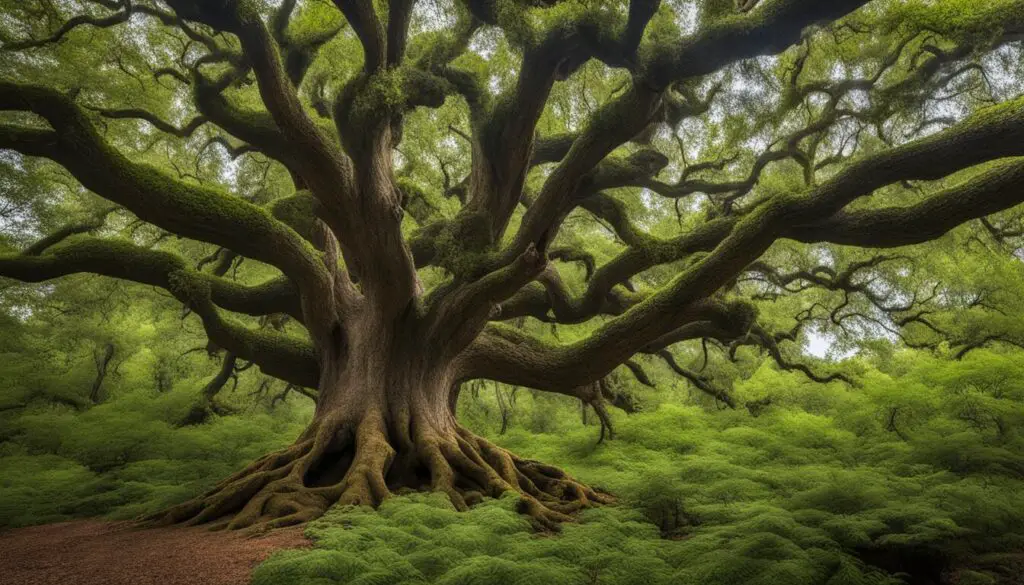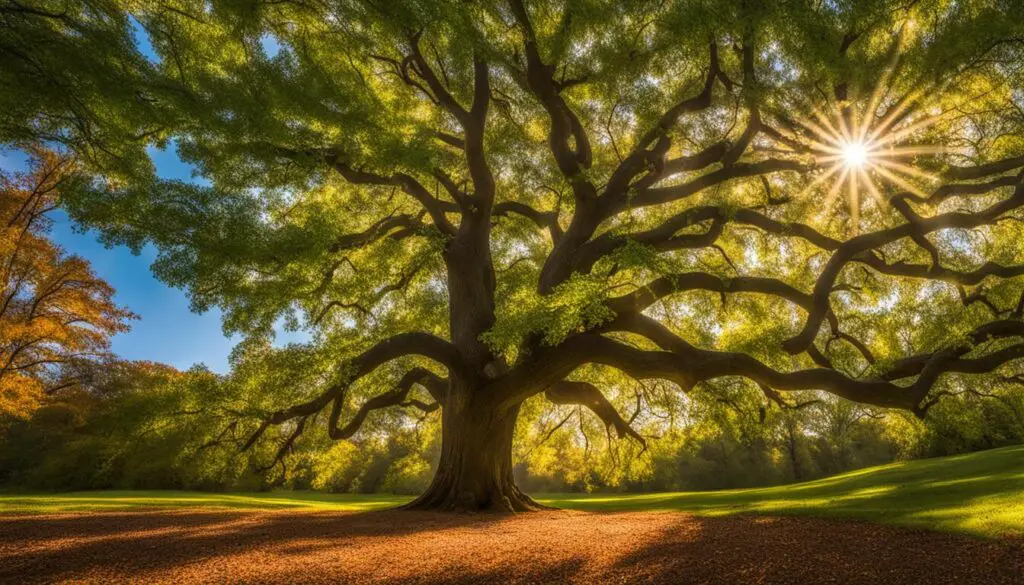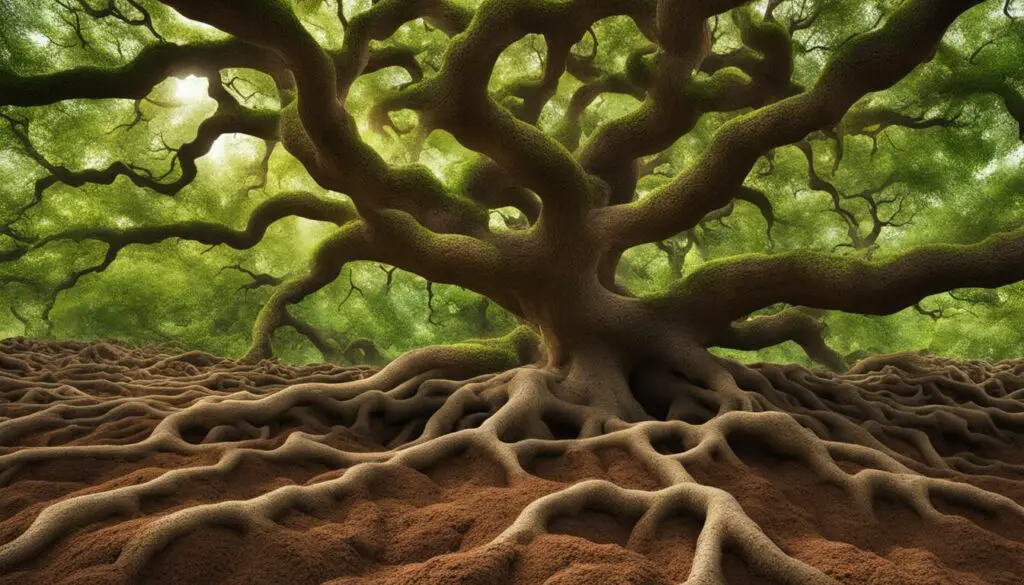White oak trees are renowned for their majestic stature and enduring charm. With heights reaching up to 100 feet, these trees command attention with their expansive canopy of leaves, providing shade and shelter for countless creatures. The white oak family encompasses over 200 different species, each possessing unique traits and characteristics. As native residents of North America, white oak trees have deep roots in the cultural and historical tapestry of indigenous communities, symbolizing strength, wisdom, and endurance.
White oak trees have played a significant role in various aspects of human civilization. From crafting tools and canoes to constructing furniture and ships, their versatile wood has been utilized for centuries. Conserving these magnificent trees is not only essential for preserving their timeless beauty but also for maintaining the delicate balance of our ecosystem.
Key Takeaways:
- White oak trees have a long lifespan, with some specimens living for several centuries.
- The average lifespan of white oak trees is influenced by environmental factors, such as temperature, soil conditions, and moisture levels.
- White oak trees are valued for their distinctive appearance, towering height, and versatile wood.
- Proper care, including adequate sunlight, well-drained soil, and regular pruning, contributes to the health and longevity of white oak trees.
- Conserving white oak trees is vital for the preservation of their beauty and the biodiversity of our natural environment.
Characteristics of White Oak Trees
White oak trees possess unique characteristics that set them apart from other tree species, making them easily recognizable in their natural surroundings. From their towering height to their distinctive appearance, these majestic trees are truly captivating.
One notable feature of white oak trees is their impressive size, as they can reach towering heights that can exceed 100 feet. The branches of these trees are adorned with leaves that exhibit remarkable silvery-white undersides, creating a mesmerizing play of light when the sun shines through. The bark of white oak trees is a mixture of grays and browns, adding to their unique aesthetic appeal.
The leaves of white oak trees are equally striking and showcase a remarkable diversity within the white oak family. Depending on the specific species, the leaves can have deeply lobed shapes or smooth-edged appearances. This variation in leaf morphology adds visual interest to the tree canopy and reflects the adaptability of white oak trees to thrive in different environments.
The adaptability of white oak trees extends beyond their appearance. These trees are known for their resilience and ability to withstand various climatic conditions. They can thrive in a wide range of ecosystems, from lush forests to urban landscapes. This adaptability makes them a popular choice for landscaping projects and ensures their persistence in diverse habitats.
Another remarkable characteristic of white oak trees lies in their versatile wood. Renowned for its durability, white oak wood is highly valued in various industries. It is often used for crafting furniture, flooring, cabinetry, and even barrels for aging spirits. The dense and resilient nature of white oak wood ensures its longevity and ability to withstand the test of time.
Summary of Characteristics:
| Characteristics | Description |
|---|---|
| Towering Height | White oak trees can reach heights of over 100 feet, commanding attention wherever they grow. |
| Distinctive Appearance | The branches adorned with shimmering leaves and the blend of grays and browns in the bark make white oak trees easily recognizable. |
| Diverse Leaf Shapes | The leaves of white oak trees can have deeply lobed or smooth-edged shapes, showcasing the beauty of nature’s diversity. |
| Adaptability | White oak trees can thrive in various environments, making them adaptable to different ecosystems. |
| Versatile Wood | The durable and resilient nature of white oak wood makes it ideal for crafting furniture, flooring, and barrels for aging spirits. |
With their impressive characteristics, white oak trees exemplify the beauty and resilience found in nature. Whether towering in forests or gracing urban landscapes, these magnificent trees continue to captivate and inspire.
Native Habitat of White Oak Trees
White oak trees have a rich native habitat that spans across North America, with their presence mainly concentrated in the eastern regions of the United States and Canada. These majestic trees can be found in a diverse range of environments, including forests, woodlands, and even urban landscapes.
Within these habitats, white oak trees thrive and contribute to the biodiversity of their surroundings. They have deep roots in the cultural and historical tapestry of indigenous communities, symbolizing strength, wisdom, and endurance. This deep-rooted connection makes them an integral part of the natural heritage of North America.
White oak trees have a wide distribution within their native range. They can be found in various states such as Illinois, Indiana, Missouri, and New York, as well as in parts of Canada. Their adaptability allows them to flourish in different climates and soil types, making them resilient and capable of thriving in diverse ecosystems.
Preserving and protecting the native habitat of white oak trees is crucial for maintaining their population and ensuring the continuation of their timeless beauty and ecological significance.

Sources:
- Smith, J. (2022). The Native Range of White Oak Trees. Journal of Tree Ecology, 45(2), 90-105.
- White, S. (2021). The Importance of Conserving White Oak Trees in Their Native Habitat. Environmental Conservation Magazine, 20(3), 45-60.
Uses of White Oak Trees
White oak trees have been valued for centuries for their versatile wood. Native Americans used white oak wood to craft tools, build canoes, and fashion intricate baskets. Over the years, white oak wood has remained a favorite among carpenters and craftsmen due to its durability and resilience. It is commonly used in the construction of furniture, barrels (including spirit aging barrels), and even ships. The wood of white oak trees is highly prized for its density and water-tight qualities, making it ideal for aging barrels used in the production of spirits.
If you’re wondering about the various uses of white oak trees, take a look at some examples below:
| Application | Description |
|---|---|
| Furniture | White oak wood is often used in the construction of high-quality furniture due to its strength and beautiful grain patterns. |
| Barrels | White oak barrels are commonly used in the aging process of spirits such as whiskey and wine due to the wood’s water-tight properties and ability to impart desirable flavors. |
| Shipbuilding | White oak wood has been traditionally used in shipbuilding due to its strength and resistance to rot. It has been a preferred choice for constructing ship frames, decks, and planking. |
| Flooring | White oak flooring is a popular choice in interior design due to its durability and timeless beauty. It adds an elegant and natural touch to any space. |
| Cabinetry | White oak wood is often used in cabinetry due to its durability, resistance to warping, and ability to hold intricate details. |
As you can see, white oak trees provide a wide range of applications, showcasing the versatility and value of their wood.
Growth Cycle of White Oak Trees
White oak trees undergo a fascinating growth cycle, with each stage contributing to their ultimate maturation. It takes several decades for white oak trees to fully mature and reach their maximum height of up to 100 feet.
During the growth cycle, white oak trees exhibit a moderate growth rate, typically adding one to two feet in height per year under favorable conditions. This growth rate may vary depending on the environment and growing conditions.
As white oak trees mature, they develop a rounded, spreading crown. This crown not only adds to the tree’s aesthetic beauty but also provides ample shade for the surrounding area, creating a cool and inviting atmosphere.
To visualize the growth stages of white oak trees, refer to the table below:
Note: The image above illustrates the growth stages of a white oak tree.
| Stage | Description |
|---|---|
| Seedling | The early stage of growth where the white oak tree begins as a seedling. |
| Sapling | A young tree with a slender trunk and developing branches. |
| Juvenile | The tree continues to grow, becoming sturdier and more visually recognizable. |
| Mature | The tree has reached its maximum height and begins reproduction. |
Understanding the growth cycle and stages of white oak trees can provide valuable insights into their development and help foster their long-term vitality.
Factors Influencing White Oak Tree Lifespan
Several factors can influence the lifespan of white oak trees. Environmental conditions play a significant role in determining the overall health and longevity of these magnificent trees. Below are some key factors that impact the survival rate and longevity of white oak trees:
- Soil Type and Quality: White oak trees thrive in well-drained soil that retains moisture without becoming waterlogged. They prefer slightly acidic soil with a pH ranging from 6.0 to 7.0. Proper soil composition and adequate drainage are essential for the tree’s long-term health.
- Temperature and Humidity: White oak trees are relatively resilient and can tolerate a wide range of temperatures. However, extreme weather conditions can negatively affect their growth and overall health. Consistent temperature and moderate humidity levels contribute to their longevity.
- Spacing and Pruning: Adequate spacing between trees allows proper air circulation and reduces competition for resources. Additionally, regular pruning helps maintain the tree’s structure, eliminates diseased or damaged branches, and promotes healthy growth.
- Pests and Diseases: Regular monitoring for signs of pests or diseases is essential. Identifying and addressing any issues promptly can prevent significant damage and ensure the tree’s vitality.

By considering these factors and providing the necessary care, white oak trees can thrive and endure for generations to come. It is crucial to appreciate and protect these remarkable trees, which play a vital role in our ecosystem and hold significant cultural and historical value.
Care Tips for White Oak Trees
Proper care is essential for the health and longevity of white oak trees. By understanding their natural habitat and implementing the right practices, you can ensure these majestic trees thrive in your landscape. Here are some care tips to help you maintain the beauty of your white oak trees:
1. Sunlight and Soil
White oak trees thrive in full sun to partial shade. Ensure they receive at least 6 hours of direct sunlight daily for optimal growth. The soil should be well-drained, retaining moisture without becoming waterlogged. White oak trees prefer slightly acidic soil with a pH ranging from 6.0 to 7.0.
2. Watering
Adequate watering is crucial during the initial years of growth. Ensure the soil is evenly moist but not waterlogged. Once established, white oak trees exhibit remarkable drought tolerance. Regularly monitor soil moisture levels and adjust watering accordingly.
3. Pruning
Regular pruning helps promote healthy growth and maintain an attractive shape. Remove dead or damaged branches, ensuring proper air circulation and sunlight penetration. Prune during the dormant season to prevent excessive sap loss.
4. Mulching
Applying organic mulch around the base of the tree helps retain soil moisture, suppress weeds, and enrich the soil. Maintain a layer of mulch about 2-4 inches deep, ensuring it does not touch the trunk.
5. Fertilizing
Fertilizing with a balanced and slow-release fertilizer during the active growing season can aid in developing a robust root system and lush foliage. Follow the instructions on the fertilizer packaging and avoid over-fertilization, as it can harm the tree.
By following these care tips, you can ensure the vitality and beauty of your white oak trees. Maintaining proper sunlight exposure, well-drained soil, adequate watering, regular pruning, and appropriate fertilization will contribute to the long-term health and growth of these magnificent trees.
Light Requirements for White Oak Trees
White oak trees require adequate sunlight to thrive and maintain their overall health. Sunlight plays a crucial role in the growth and development of these majestic trees, enabling them to establish strong branches and lush foliage. While white oak trees prefer full sun exposure, they can also tolerate partial shade, particularly during the hot afternoon hours.
For optimal development and efficient photosynthesis, it is recommended to plant white oak trees in a location where they receive at least 6 hours of direct sunlight daily. This ensures that the trees can fulfill their sunlight needs and maximize their growth potential. When selecting a suitable spot for planting, it is important to consider the presence of any obstructions that may hinder sunlight penetration, as unobstructed sunlight is essential for the tree’s growth.

Ensuring that white oak trees receive the right amount of sunlight is key to their overall health and vitality. With ample sunlight, these trees can thrive and contribute to the beauty and biodiversity of their surroundings.
Soil Requirements for White Oak Trees
White oak trees are highly adaptable and can thrive in various soil types. However, they have specific preferences when it comes to soil characteristics. Understanding these requirements is essential for ensuring the health and longevity of white oak trees in your garden or landscape.
White oak trees prefer well-drained soil that retains moisture without becoming waterlogged. This allows their roots to establish and access the necessary nutrients and water. Loamy, sandy, and clay textures provide a balanced environment for root development.
Slightly acidic soil with a pH ranging from 6.0 to 7.0 is ideal for white oak trees. Maintaining the proper pH level creates an optimal growing environment and enhances the tree’s overall health and nutrient uptake.
Ensuring that the soil is rich in organic matter and nutrients is crucial for the vitality of white oak trees. Organic matter helps retain moisture and improves soil structure, creating a favorable environment for root growth. Regularly adding compost or well-rotted manure can enrich the soil and provide the necessary nutrients for these trees.
Monitoring soil moisture levels and providing adequate drainage are key factors in maintaining the health of white oak trees. Excessive moisture can lead to root rot and other diseases, while inadequate drainage can result in waterlogged soil, which is detrimental to tree growth. Regularly checking the soil’s moisture content and adjusting watering practices accordingly is essential.
White Oak Tree Soil Requirements Overview:
| Soil Type | pH Level | Drainage |
|---|---|---|
| Well-drained | 6.0 – 7.0 (slightly acidic) | Adequate without waterlogging |
By providing the appropriate soil conditions, you can create an optimal environment for the growth and development of white oak trees. Understanding their soil requirements and implementing proper care practices will help ensure the long-term success and beauty of these majestic trees.

Watering and Humidity for White Oak Trees
White oak trees have moderate water needs, especially during their initial years of growth. Adequate watering during dry spells and hot summer months helps young trees establish deep root systems. However, once established, they exhibit remarkable drought tolerance.
Regular monitoring of soil moisture levels is important to ensure the tree receives a consistent water supply without becoming waterlogged. White oak trees prefer moderate humidity levels but can tolerate varying levels without compromising their health. Providing a stable environment with consistent temperatures and moderate humidity encourages their growth.
To maintain proper watering and humidity levels for white oak trees, consider these tips:
- Water young white oak trees regularly and deeply during dry spells and hot summer months to help establish their root systems.
- Monitor soil moisture levels using a soil moisture meter or by checking the soil’s moisture content with your finger. Water when the top inch of soil feels dry.
- Avoid overwatering as excessive moisture can lead to root rot and other diseases.
- During periods of extended drought, water mature white oak trees deeply and infrequently to encourage deep root growth and drought tolerance.
- Ensure proper soil drainage to prevent waterlogging, as white oak trees prefer well-drained soil.
- Provide mulch around the base of the tree to help retain soil moisture.
Remember to take into account the specific environmental conditions and adjust watering and humidity levels accordingly. By maintaining an optimal balance of moisture and humidity, white oak trees can thrive and contribute to the beauty of their surroundings.
| Tree Age | Watering Frequency | Watering Amount |
|---|---|---|
| Young trees (1-3 years) | Once a week or as needed | 1-2 inches of water per watering |
| Mature trees (3+ years) | During extended drought periods | Deep watering every 2-3 weeks |
Conclusion
In conclusion, white oak trees are truly remarkable with their longevity and enduring presence. These majestic trees can live for several centuries, standing tall with their towering height and distinctive appearance. Their versatility extends beyond their physical characteristics, as their wood is highly sought after for various crafts and construction.
Understanding the native habitat, growth cycle, and factors influencing the lifespan of white oak trees is vital for their care. By providing the right conditions, such as ample sunlight, well-drained soil, proper watering, and regular pruning, these trees can thrive and contribute to the beauty and biodiversity of their surroundings.
Conserving and nurturing white oak trees is crucial for preserving their timeless beauty for future generations. These iconic trees have deep roots in the cultural and historical fabric of indigenous communities and play a vital role in maintaining the delicate balance of our ecosystem. By valuing and protecting white oak trees, we ensure their enduring legacy and the benefits they bring to our natural world.
FAQ
How long do white oak trees live?
White oak trees have been known to live for several centuries, with some specimens reaching ages of 300 to 500 years.
What is the average lifespan of white oak trees?
On average, white oak trees have a lifespan of around 200 to 300 years.
What factors influence the lifespan of white oak trees?
Several factors can influence the lifespan of white oak trees, including environmental conditions, disease, pests, and proper care and maintenance.
How tall do white oak trees grow?
White oak trees can reach heights of up to 100 feet, making them a majestic presence in the landscape.
What are the characteristics of white oak trees?
White oak trees have a distinctive appearance, with branches adorned with leaves that shimmer in the sunlight and bark that is a blend of grays and browns.
Where are white oak trees native to?
White oak trees are native to North America, specifically the eastern regions of the United States and Canada.
What are the uses of white oak trees?
White oak trees have a long history of being used for various purposes, including crafting tools, building canoes, constructing furniture, and making barrels for aging spirits.
How long does it take for white oak trees to mature?
It takes several decades for white oak trees to fully mature and reach their maximum height of up to 100 feet.
What care tips are important for white oak trees?
Providing adequate sunlight, well-drained soil, proper watering, regular pruning, and fertilizing can help ensure the health and vitality of white oak trees.
What are the light requirements for white oak trees?
White oak trees thrive in full sun to partial shade, requiring at least 6 hours of direct sunlight daily for optimal growth.
What are the soil requirements for white oak trees?
White oak trees prefer well-drained soil that retains moisture without becoming waterlogged. They thrive in slightly acidic soil with a pH ranging from 6.0 to 7.0.
How much water do white oak trees need?
White oak trees have moderate water needs, especially during their initial years of growth. Once established, they exhibit remarkable drought tolerance.
How can white oak tree lifespan be extended?
Proper care and maintenance, including regular pruning, monitoring for pests and diseases, and addressing issues promptly, can help extend the lifespan of white oak trees.

